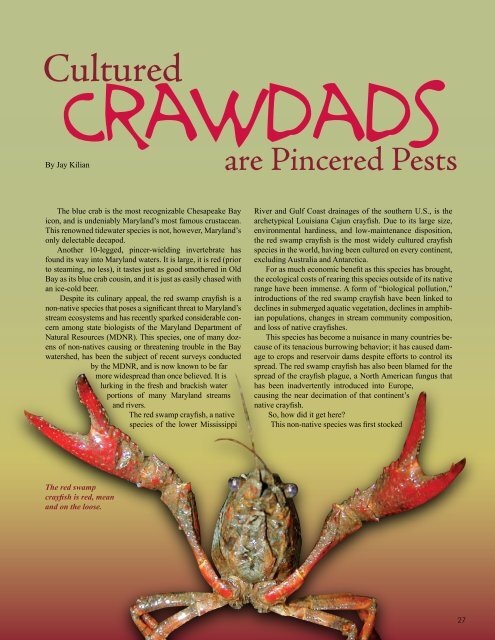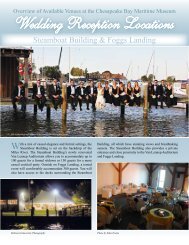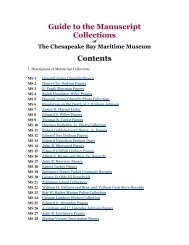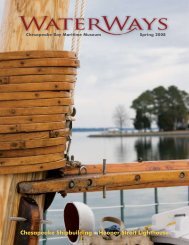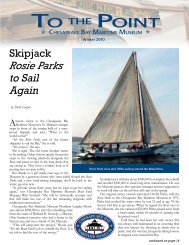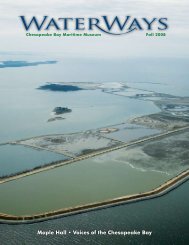Pocomoke Shipbuilding • Vane Brothers - Chesapeake Bay ...
Pocomoke Shipbuilding • Vane Brothers - Chesapeake Bay ...
Pocomoke Shipbuilding • Vane Brothers - Chesapeake Bay ...
Create successful ePaper yourself
Turn your PDF publications into a flip-book with our unique Google optimized e-Paper software.
Cultured<br />
Crawdads<br />
By Jay Kilian<br />
The blue crab is the most recognizable <strong>Chesapeake</strong> <strong>Bay</strong><br />
icon, and is undeniably Maryland’s most famous crustacean.<br />
This renowned tidewater species is not, however, Maryland’s<br />
only delectable decapod.<br />
Another 10-legged, pincer-wielding invertebrate has<br />
found its way into Maryland waters. It is large, it is red (prior<br />
to steaming, no less), it tastes just as good smothered in Old<br />
<strong>Bay</strong> as its blue crab cousin, and it is just as easily chased with<br />
an ice-cold beer.<br />
Despite its culinary appeal, the red swamp crayfish is a<br />
non-native species that poses a significant threat to Maryland’s<br />
stream ecosystems and has recently sparked considerable concern<br />
among state biologists of the Maryland Department of<br />
Natural Resources (MDNR). This species, one of many dozens<br />
of non-natives causing or threatening trouble in the <strong>Bay</strong><br />
watershed, has been the subject of recent surveys conducted<br />
by the MDNR, and is now known to be far<br />
more widespread than once believed. It is<br />
lurking in the fresh and brackish water<br />
portions of many Maryland streams<br />
and rivers.<br />
The red swamp crayfish, a native<br />
species of the lower Mississippi<br />
The red swamp<br />
crayfish is red, mean<br />
and on the loose.<br />
are Pincered Pests<br />
River and Gulf Coast drainages of the southern U.S., is the<br />
archetypical Louisiana Cajun crayfish. Due to its large size,<br />
environmental hardiness, and low-maintenance disposition,<br />
the red swamp crayfish is the most widely cultured crayfish<br />
species in the world, having been cultured on every continent,<br />
excluding Australia and Antarctica.<br />
For as much economic benefit as this species has brought,<br />
the ecological costs of rearing this species outside of its native<br />
range have been immense. A form of “biological pollution,”<br />
introductions of the red swamp crayfish have been linked to<br />
declines in submerged aquatic vegetation, declines in amphibian<br />
populations, changes in stream community composition,<br />
and loss of native crayfishes.<br />
This species has become a nuisance in many countries because<br />
of its tenacious burrowing behavior; it has caused damage<br />
to crops and reservoir dams despite efforts to control its<br />
spread. The red swamp crayfish has also been blamed for the<br />
spread of the crayfish plague, a North American fungus that<br />
has been inadvertently introduced into Europe,<br />
causing the near decimation of that continent’s<br />
native crayfish.<br />
So, how did it get here?<br />
This non-native species was first stocked<br />
27


